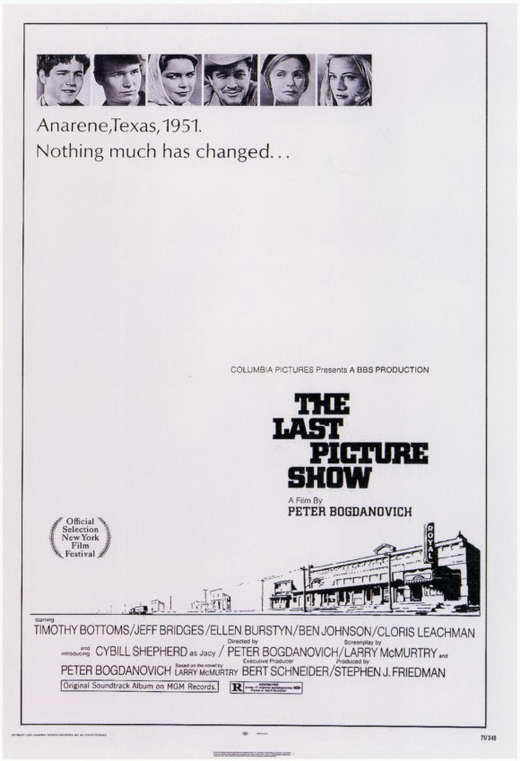Kerri Battles the AFI’s Top 100 – #95: The Last Picture Show

Until now, I’d come to regard The Last Picture Show as a mythical creature, sort of like Bigfoot or the Chupacabra. It’s always being hailed or referenced somewhere as though it changed cinema forever, but I’ve never actually met anyone who has seen it in real life. I’ve also never heard it described more specifically than, “a coming of age story.” All I really knew going in was that it was filmed in black and white in 1971, which meant it was probably going to be pretty arty, and people always cite it as proof that Jeff Bridges can act, so he was probably going to be in it. Beyond that, I hadn’t a clue.
Post-credits, I still don’t really have a clue. If you asked me to succinctly explain the plot of the movie, I would probably tell you it’s about how a terrible high school football team in west Texas will destroy an entire town and, in turn, drive all of its inhabitants mildly insane. To say more than that would probably require explaining the entire film, beginning with character backstories. At that point, you should just watch the movie. And you should watch the movie. I can’t explain why, but I was rivetted. There were moments when I thought the film looked overexposed, that the editing was bizarre and jump, or that the story was disconnected, but it didn’t matter. I still couldn’t look away. I definitely learned why the AFI put this flick on the list. I just haven’t figured out how to explain it. In lieu of that, I figured I’d share a few other things I learned from The Last Picture Show that I did figure out how to explain.
Cloris Leachman Can ACT.

*Insert Horse Whinny Here*
Frau Blucher — or some other iteration of a Mel Brooks female sidekick — is probably how I know Cloris Leachman best. It’s also what I psychotically love her for. Having been raised on Mel Brooks fare, she feels like a part of my childhood, like a goofy old grandmother who always made me laugh. So imagine my surprise when I watched her play a 40-something housewife having an affair with a senior on the football team. For the first 10 minutes or so after the introduction of her character, I kept half-expecting her to be the comic relief. Instead, she gave a tragic and nuanced performance that left me wondering for most of the movie exactly how old her character was supposed to be. I have a working theory that great comedic actors can easily slip into a dramatic role with little to no effort and, after watching The Last Picture Show, I’m adding Cloris Leachman to the list of actors I routinely use as evidence.
Cybill Shepherd Drinks Unicorn Blood


Remember Cybill Shepherd? She was TV’s It Girl in the 80s when she was in that show with Bruce Willis when he still had hair? The photo on the left is a still from The Last Picture Show, when Cybill was about 21. The one on the right was taken sometime last year, when she was about 64. SIXTY. FOUR. Now, I’m not saying she looks like she hasn’t aged a day since then, but JESUS. Screw renting a house in the Isle of Wight if it’s not too dear. I just want to look like Cybill Shepherd when I’m 64. And the fact that she does look like she’s aged a day or two means she’s gone about it (probably mostly) naturally. That’s something to be applauded and respected in a world where Meg Ryan and Melanie Griffith are no longer recognizable as human beings, let alone celebrities.
Randy Quaid didn’t get weird looking with age…

He looks sort of like if a bobble head mated with a potato.
All I can really say about this is that I found Randy Quaid’s maybe 15 minutes of screen time so very distracting simply because I couldn’t wrap my head around the fact that he got less weird looking as he aged. I mean, Randy Quaid has always been one weird, goofy looking dude. One of the great mysteries of Hollywood is how a guy who looks like Randy Quaid could be so closely related to a guy who spent a career landing nothing but romantic leads and aging baseball player roles. The visage of a young Randy Quaid has only, in my mind, deepened the mystery.
Peter Bogdanovich in General

I’ve spent most of my life watching Peter Bogdanovich host Biography and AFI specials or show up in cameo spots, like as Melfi’s therapist on The Sopranos. The world seemed to insinuate that he was famous, but I never knew why. I honestly assumed he was some sort of aging actor, like Elliott Gould, but not nearly as talented. It turns out that this guy actually directed The Last Picture Show and was, at one point, considered to be on par with Francis Ford Coppola. He made 2 more critically acclaimed box office hits after The Last Picture Show, but then his story turned all too familiar. He made a couple of flops and took some time off from directing. His supposed triumphant return starred his Playboy Bunny girlfriend, who was murdered by her estranged husband before the movie could be released. Bogdanovich ultimately wrote a book about the whole thing and married her 20 year old sister (he was 49), whom he had started dating when she was 14. For some reason, Hollywood and the viewing public just did not respond favorably to such a beautiful love story.
If you’re now thinking that maybe some of these things are a case against The Last Picture Show instead of for, just go watch the movie. Then you’ll understand precisely what I’m completely incapable of adequately articulating here. It’s really, really good. I promise. I just can’t exactly explain why. –KS
